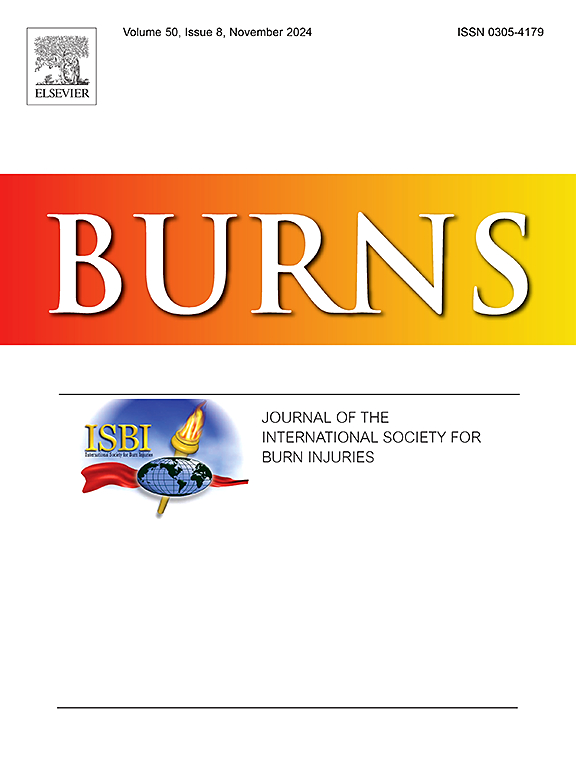Analyzing burns incidence trends in BRICS from 1990 to 2021: Findings from the Global Burden of Disease
IF 2.9
3区 医学
Q2 CRITICAL CARE MEDICINE
引用次数: 0
Abstract
Background
Burns constitute a significant global public health challenge. The BRICS nations (Brazil, Russia, India, China, South Africa, Saudi Arabia, Egypt, United Arab Emirates, Iran, Ethiopia) represent emerging economies encompassing nearly half the global population. This study analyzes burns incidence trends across BRICS countries from 1990 to 2021, providing evidence to inform prevention and management strategies.
Methods
Analysis of burns incidence data through age-period-cohort modeling, decomposition analysis, health disparities analysis, frontier analysis, and Bayesian age-period-cohort modeling of future incidence rates.
Results
In 2021, BRICS nations collectively reported 5.90 million burn cases, accounting for 2.40 % of all injuries, with a 21.30 % decrease in age-standardized incidence rates (ASIR) from 1990 to 2021. Iran experienced the most significant ASIR reduction (-67.10 %), while China had the smallest decrease (-14.40 %). Health disparities between high- and low-income countries widened over time. Despite high Socio-Demographic Index (SDI) rankings, Russia and Saudi Arabia exhibited elevated burn incidence rates. Linear Age Trends (LAT) for burn reduction varied among countries. In South Africa, burns were primarily caused by fire, heat, and hot substances (60.41 % of cases), while falls accounted for 37.44 % of burns in Saudi Arabia. Projections indicate declining ASIR from 2022 to 2035, with Russia projected to have the highest ASIR (336.76 per 100,000) and Iran the lowest (86.54 per 100,000).
Conclusion
Burns pose a major global public health challenge, necessitating action from national policymakers to address the increasing incidence of industrial accidents, household fires, natural disasters, and conflicts. The results of our analysis can help policymakers develop more effective burn prevention strategies.
分析金砖国家1990年至2021年烧伤发病率趋势:来自全球疾病负担的发现
烧伤是一项重大的全球公共卫生挑战。金砖国家(巴西、俄罗斯、印度、中国、南非、沙特阿拉伯、埃及、阿拉伯联合酋长国、伊朗、埃塞俄比亚)代表着占全球人口近一半的新兴经济体。本研究分析了金砖国家1990年至2021年烧伤发病率趋势,为预防和管理战略提供证据。方法采用年龄-时期-队列模型、分解分析、健康差异分析、前沿分析和贝叶斯年龄-时期-队列模型对烧伤发病率数据进行分析。结果2021年,金砖国家共报告了590万例烧伤病例,占所有伤害的2.40% %,1990年至2021年,年龄标准化发病率(ASIR)下降了21.30% %。伊朗经历了最显著的ASIR下降(-67.10 %),而中国的下降最小(-14.40 %)。高收入国家和低收入国家之间的健康差距随着时间的推移而扩大。尽管社会人口指数(SDI)排名较高,但俄罗斯和沙特阿拉伯的烧伤发病率较高。烧伤减少的线性年龄趋势(LAT)因国家而异。在南非,烧伤主要是由火、热和热物质引起的(60.41 %的病例),而在沙特阿拉伯,跌倒占37.44 %的烧伤。预测显示,从2022年到2035年,ASIR将下降,俄罗斯的ASIR预计最高(每10万人中有336.76人),伊朗最低(每10万人中有86.54人)。烧伤是一项重大的全球公共卫生挑战,需要各国决策者采取行动,解决日益增加的工业事故、家庭火灾、自然灾害和冲突发生率。我们的分析结果可以帮助决策者制定更有效的烧伤预防策略。
本文章由计算机程序翻译,如有差异,请以英文原文为准。
求助全文
约1分钟内获得全文
求助全文
来源期刊

Burns
医学-皮肤病学
CiteScore
4.50
自引率
18.50%
发文量
304
审稿时长
72 days
期刊介绍:
Burns aims to foster the exchange of information among all engaged in preventing and treating the effects of burns. The journal focuses on clinical, scientific and social aspects of these injuries and covers the prevention of the injury, the epidemiology of such injuries and all aspects of treatment including development of new techniques and technologies and verification of existing ones. Regular features include clinical and scientific papers, state of the art reviews and descriptions of burn-care in practice.
Topics covered by Burns include: the effects of smoke on man and animals, their tissues and cells; the responses to and treatment of patients and animals with chemical injuries to the skin; the biological and clinical effects of cold injuries; surgical techniques which are, or may be relevant to the treatment of burned patients during the acute or reconstructive phase following injury; well controlled laboratory studies of the effectiveness of anti-microbial agents on infection and new materials on scarring and healing; inflammatory responses to injury, effectiveness of related agents and other compounds used to modify the physiological and cellular responses to the injury; experimental studies of burns and the outcome of burn wound healing; regenerative medicine concerning the skin.
 求助内容:
求助内容: 应助结果提醒方式:
应助结果提醒方式:


